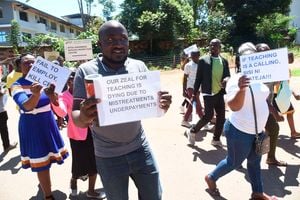Unanswered questions on new Ruto health plan as D-Day looms

National Health Insurance Fund headquarters in Nairobi.
What you need to know:
- The confusion and the disorganisation continued on Friday when a planned meeting failed to take place.
- The transition from NHIF to the new scheme will require all Kenyans, whether employed or not, to register afresh.
If all had gone to plan, Kenya would be transitioning to a new health system run by the Social Health Authority on Tuesday October 1, fully funded, with 12 million households registered and a whole new world of universal health coverage.
But three days to the big day, questions abound on the readiness of the system, its capacity, the below-par registration of would-be members, and addressing the dark past of its scandal-ridden predecessor, the National Health Insurance Fund (NHIF).
The confusion and the disorganisation continued on Friday September 27 when a planned meeting “where experts would take journalists through what Kenyans should expect from the beginning of October and how the new system will work” failed to take place.
In attendance was supposed to be the health ministry, a representative from the proposed health authority, telecommunications giant Safaricom, Apeiro and a representative from Konvergenz, who are partners in the rollout plan.
Each of the three firms will contribute to the Sh104.8 billion needed to implement, maintain and support the Integrated Healthcare Technology System (IHTS) system over the next ten years based on their shareholding.
Apeiro, an Abu Dhabi firm, owns 59.55 percent of the stake in the consortium, Safaricom has a 22.56 per cent stake, while Konvergenz Network Solutions Limited has a shareholding of 17.89 per cent.
The health authority will be divided into three funds: Primary Healthcare Fund, Social Health Insurance Fund (SHIF), and Emergency and Chronic Illnesses Fund.
This transition from NHIF to the new scheme will require all Kenyans, whether employed or not, to register afresh to receive services from any of the government’s contracted health facilities.
The ministry has in recent days emphasised that registration is mandatory, unlike NHIF where registrations were voluntary. And this, it appears, is the government’s first big problem.
While the State is targeting to register all 12 million households, by yesterday, it had only done 1.9 million — a mere 15.83 per cent.
Fearing this unmet target, the ministry has sought the help of Interior Ministry to take advantage of its National Government Administration Officers to boost the numbers.
Through this plan, the two ministries said they target to hit 60 per cent of Kenya’s households by October 1.
One other plan, SHA Acting Chief Executive Officer Elijah Wachira said, is for every unregistered user seeking services to be made to register first before being attended to.
For emphasis, this means that to get any service, of whatever nature even at a local dispensary, one will be required to first register.
“I am saying it (registration) is mandatory because we are implementing the act as it is,” said Mr Wachira.
Medical Services Permanent Secretary Harry Kimtai said earlier this week that the last reimbursement under NHIF will lapse on the night of September 30, 2024.
Mr Wachira, the acting CEO of SHA, explained this in detail: “What we mean is that come October 1, the NHIF card will not be useful anymore. It’s your ID that is useful.”
“Anybody who goes to the hospital, is treated, discharged, inpatient or outpatient, effective October 1, will be treated under the Social Health Authority benefits,” remarked PS Kimtai in a past briefing.
“We have also made a provision that if you reach the hospital, in case of an emergency and you have not registered by that time, which we’re not encouraging, there will be an agent who would have been appointed by SHA to take care of the registration,” added PS Kimtai.
For instance, employers are expected to remit their employees' contributions by the 9th of the subsequent month.
As such, Mr Wachira explained, the new rates will affect the payslip for October and not September.
“Employed persons who are registered will be able to access services but their premiums will be received at the end of the month once the employers remit into SHA.”
If a salaried individual does not key in their details, Mr Wachira emphasised that the employer is still mandated to deduct from their payslips.
“Insurance is a business of pooling resources, and all employers are required by law to remit premiums relating to their employees and in this case, it is 2.75 per cent of their salary. When this particular employee is not well and required to use the service, then they will be required to first register and maybe there will be a problem reconciling what had been remitted because it will be in a suspense account,” said Mr Wachira.
For the non-salaried, they will be required to fill out a questionnaire and a means testing tool will be used to determine how much they should pay, with Sh300 being the least amount payable.
A key distinction between salaried and self-employed contributors lies in the contribution structure: salaried employees will make monthly contributions through their employers, while self-employed individuals will be required to make a one-off annual payment before accessing the benefits package under SHIF.
According to the SHA Act, any person who fails to pay in respect of the required period shall be liable to a two per cent penalty of the amount due of the contribution for the period in which the payments are not made.
The mandatory requirements come as the government seeks to drive compliance and generate revenue by targeting all households to finance the universal health coverage.
The government has so far allocated Sh6.1bn for SHA, against a Sh168bn figure for the full implementation.
“The plan is that there will be supplementary budgets to ensure that any gap between service delivery and resources available is filled,” says Mr Wachira, the SHA acting chief executive officer.
The rollout of the SHA Act has been anything but smooth. On one hand, court interventions have delayed its progress.
In July, the issue of mandatory registration into the new social health scheme was a matter in court, and a three-judge bench gave the government 120 days to fix the breaches.
On September 20, the Appellate Court gave MOH the green light to proceed with the rollout plan, including registrations of individuals into the scheme, pending an authoritative ruling on the validity of the Social Health Insurance Act 2023, Primary Health Care Act 2023, and the Digital Health Act 2023.
On the other hand, with just a few days before they remit 2.75 per cent of their earnings into the scheme, many Kenyans remain unclear about its purpose, benefits packages and operationalisation.
On the financial projections of SHIF, the authority seeks to raise more than Sh100 billion annually from paid-up members.
The government will fund services offered under Primary Healthcare and Emergency and Critical Illnesses Fund.
In a 2022 report by the now-defunct NHIF, the cumulative members for 2020/2021 were about 23 million beneficiaries consisting of 9.96 million cumulative principal members.
In the same period, the institution collected 39.47 billion, a quarter of the amount that the Authority hopes to raise under SHIF. For those who have already registered, there are teething problems.
An X user lamented that they had created a SHA account a few days ago, only to find out that his list of dependents included an 11-year-old daughter he knew nothing about, and he had no option to delete the erroneous entry.
According to Mr Wachira, there was no cause for alarm, the new registration process, which involves entering personal and dependent details, is necessary because the data transferred from NHIF may be inaccurate or misleading.
“The data in NHIF is about three or so million that is not clean,” he said.
Mr Wachira insists that SHA had better benefits than NHIF as it included primary healthcare and emergency treatment without premium payments, outpatient care to include chronic disease management and preventive services, accessible to all, maternal care including postnatal visits, Anti-D serum and increased reimbursements for deliveries.
Mr Wachira says SHA introduces mental health services are introduced, with reduced costs for rehabilitation and higher rebates for hospital admissions, as well as expanded coverage for cancer and sickle cell disease treatments, new optical services like eye exams and corrective glasses, and the introduction of dental care.
He added that screening for common cancers and chronic conditions will begin in the second year, alongside emergency treatment and evacuation services for all Kenyans.




